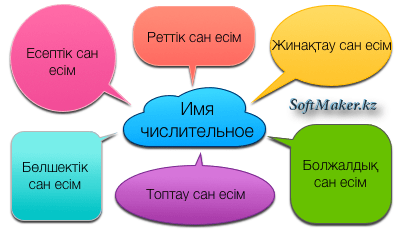Cardinal numeral (eseptik san esim) of the Kazakh language
Good day, dear blog readers of our website SoftMaker.kz! Cardinal numeral adjective (eseptik san esim) of the Kazakh language answers questions qansha? neshe? (how much?).
The contents
- Examples of the cardinal numerals
- Rules for the use of the compound cardinal numerals
- Cardinal numerals in the function of definition
- The use of the cardinal numerals in sentences
Examples of the cardinal numerals
The cardinal numerals are:
- Dara (simple) and consist of one word:
| One – bir | Nine – toǵyz | Eighty – seksen |
| Two – eki | Ten – on | Ninety – toqsan |
| Three – úsh | Twenty – jıyrma | Hundred – júz |
| Four – tórt | Thirty – otyz | Thousand – myń |
| Five – bes | Forty – qyryq | Million – mıllıon |
| Six – alty | Fifty – elý | Billion – mıllıard |
| Seven – jeti | Sixty – alpys | Trillion – trıllıon |
| Eight – segiz | Seventy – jetpis | Quadrillion – kvadrıllıon |
- Kúrdeli (composite) and consist of two or more words:
| Eleven – on bir | Three hundred and two – úsh júz eki |
| Nineteen – on toǵyz | Four hundred ten – tórt júz on |
| One hundred and one – júz bir | Five hundred sixty-six – bes júz alpys alty |
| One hundred and nine – júz toǵyz | Six hundred eight – alty júz segiz |
| One thousand nine hundred and eighty-six | Myń toǵyz júz seksen alty |
| Two million five hundred thirty-four thousand six hundred eighty-seven | Eki mıllıon bes júz otyz tórt myń alty júz seksen jeti |
Here for large numbers used international names: million, billion, trillion and so on.
Rules for the use of the compound cardinal numerals
Complex (compound — kúrdeli) cardinal numerals are composed of combinations of numbers, which are listed in the first table. If we talk about the numbers from eleven to nineteen, a larger number is used at the beginning of an expression, then the smaller one.
For example, the number on is more than the number bir, so the number on we use in the beginning of the expression: first we write the number on, then join the number bir.
- on eki (twelve) — the number on is greater than the number eki
- ol alty (sixteen) — the number on is greater than the number alty
Starting with the number twenty, the word order in complex numerals is the same as in English:
- otyz bes (thirty-five) — the number otyz is greater than the number bes
- alpys alty (sixty-six) — the number alpys is greater than the number alty
In the Kazakh language, before the names of numbers: one hundred, one thousand, one million, and so on, the names of smaller numbers can be attached:
- (bir) júz elý toǵyz — one hundred and fifty-nine
- (bir) myń toǵyz júz seksen bes — one thousand nine hundred eighty-five
- toǵyz mıllıon on myń — nine million ten thousand
Cardinal numerals in the function of definition
When using cardinal numerals as a definition or words denoting an indefinite number, the noun does not take the plural ending:
- bes stýdent (five students) — bes stýdent +
ter - kóp kisi (five people) — kop kisi +
ler - jıyrma bes qoı (twenty-five sheep) — jıyrma bes qoı +
lar
The predicate of similar constructions is also written without the plural ending:
- jıyrma bes qoı jaıylyp júr (twenty-five sheep are grazing) — jıyrma bes qoı jaıylyp júr +
ler
So, in the Kazakh language, numerals in the function of definition before nouns do not change either in a number or in a case. And there is no gender in the Kazakh language. Therefore, the same numeral, depending on the meaning of the sentence, can be translated into English in the masculine or feminine gender.
The use of the cardinal numerals in sentences
- Bizdiń kýrsta jıyrma bes stýdent bar. There are twenty-five students in our course.
- Instıtýtta eki myń bes júz alpys bes stýdent oqıdy. There are two thousand five hundred and sixty-five students in the institute.
- Biz jazda alpys eki kún sovhozda jumys istegenbiz. In the summer, we worked on the farm for sixty-two days.
- Ár stýdent qyryq myń úsh júz jıyrma tórt tengeden aqsha aldy. Each student received forty thousand three hundred and twenty-four tenge.



